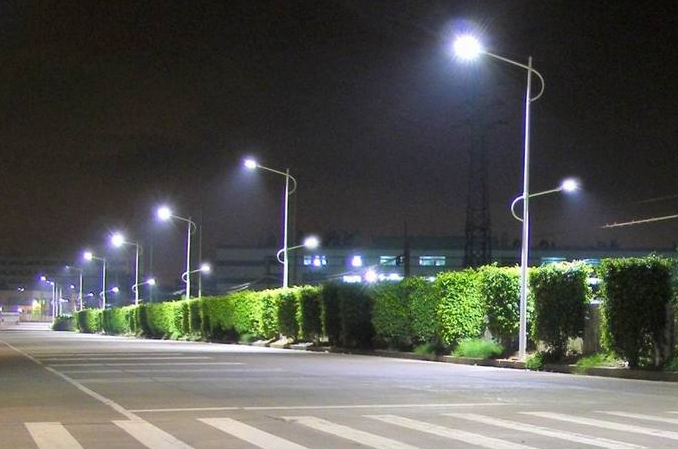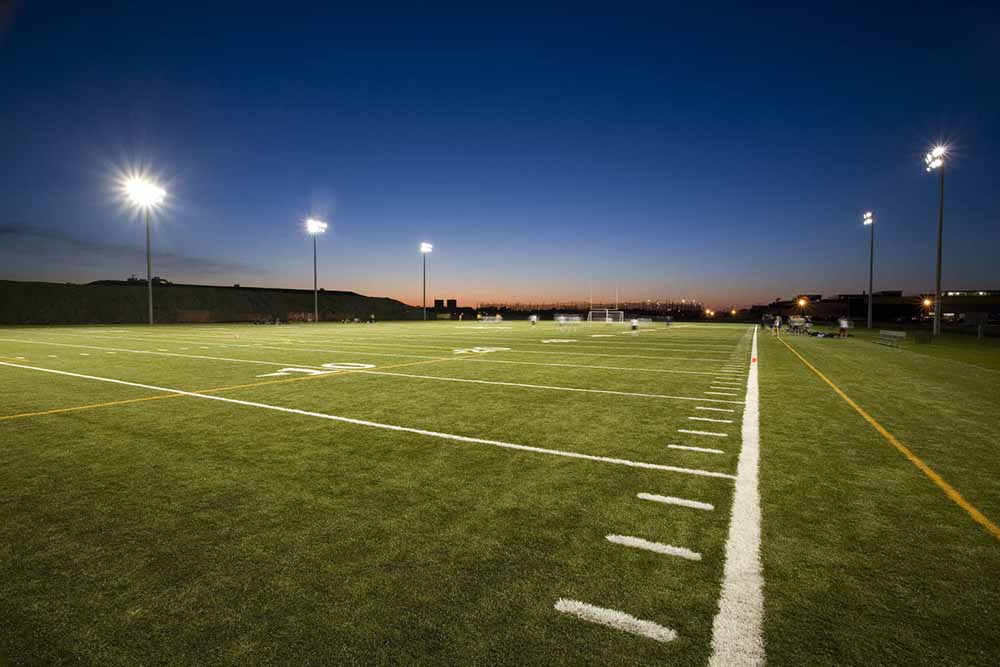There are two main types of lighting: symmetric and asymmetric. In other words, when the lighting is level across the subject, it is symmetrical lighting, but asymmetric lighting is when one side of the subject is brighter than the other. Let’s examine this closer.
You may notice that floodlights have different light beam angles. To get the best lighting effect at a variety of places, you should choose high-performance options. Those places might include sports lighting venues, stadiums, music/movie theaters, and roads.
Asymmetrical and symmetrical light distribution always sparks a great debate when it comes to the lighting of large areas. Find out more about asymmetric and symmetrical light distribution in this post.

What Is Asymmetric Lighting?
Asymmetrical lighting highlights a single focal point without dissipating in any direction. It does this with a reflecting mirror that concentrates the light beam. Thus it minimizes the reflection of unwanted light and helps reduce light pollution. And the best examples of asymmetrical illumination are streetlights, stadium lights, theater lighting and so on.
What Is Symmetric Lighting?
Lights that spread evenly in all directions, such as symmetric lights, are best suited for illuminating large areas. Therefore, you should use symmetrical lighting outdoors and accent lighting both inside and outside. Plus, you can use it for garage and porch lights.
The difference between asymmetric and symmetrical lighting
| Asymmetric Lighting | Symmetric Lighting |
| Asymmetric Lighting enlights a specific area in a definite direction. | Symmetric lighting spreads in all directions equally. |
| This lighting is ideal for focusing on a small area. | In illuminating a large area, symmetric lighting works best. |
| Unintended glaring is reduced with asymmetric lighting. | Symmetric lighting causes intended and unintended glare. |
| Asymmetric lighting prevents light pollution. | This lighting causes light pollution. |
| This lighting produces a narrow beam angle. | A wider bim angle is created in Symmetric lighting. |
| Such lighting is an effective solution for the workplace. | Symmetric lights are adequate for general lighting. |
| Asymmetric lighting reduces eye strain. | As symmetric lighting produces unnecessary glaring, it causes eye strain. |
| The brightness of the light is different in different directions. | Light brightness is equal in all directions. |
| Asymmetric lights are energy-efficient. | Such lighting wastes energy. |
| Nearly no backlight is produced in asymmetric lighting. | Symmetric light creates backlighting. |
| Best For:Focusing on a specific region Workspace and street lighting | Best For:General lighting of large areaAccent lighting |
Advantages Of Asymmetric Lighting
Asymmetric lighting is appropriate for both interior and exterior purposes. In addition, there are many advantages to consider. This list contains the following:
Lighting A Particular Area
It is highly recommended to use asymmetrical lighting when enlightening a specific space. Asymmetric lighting will brighten up any particular region in your room or space.
Prevents Light Wastage
Well, lighting the unnecessary areas is completely pointless, so only those parts requiring lighting get lit with asymmetrical lights. This means the place you’ll go stargazing has no light pollution.
Limited Light Source
As a result of asymmetrical lighting, narrow beams are created to illuminate an intended area, so there is no backlighting. Therefore, there is no need for additional lighting since it uses minimal energy for enlightening.
Cost-Effective
Asymmetrical lighting reflects light in a fixed direction. This results in a more concentrated light source while using less energy. In other words, asymmetrical lighting lowers your electricity bills.
Disadvantages Of Asymmetric Lighting
Apart from these advantages, there are a few drawbacks to asymmetric lighting. These are
- Asymmetrical lighting is not meant for general lighting; it is best for specific lighting needs.
- As no backlight is produced in the asymmetric lighting, the other half remains dark. Consequently, the room must have plenty of light for the projector to be effective.
In conclusion, these are the disadvantages of asymmetric lighting. So, before installing it for your lighting project, keep these points in mind.
Where To Use Asymmetric Lighting?
Asymmetrical lighting provides a lot of benefits, but where can it be used? It can be used in any open or closed space. Despite that, here are a few common examples of asymmetric lighting use…

Workstation
Asymmetric lighting is ideal for directing light to a specific area, such as an office table, study table, cooking station, etc.
Stadium
As asymmetric light sources only illuminate the playing field, they allow the audience to easily watch matches in stadiums. Consequently, asymmetrical lighting will prevent unexpected glare for the stadium’s audience.
Street
Streetlights are a good example of a system where several lights, the positions of which differ from those of the others, illuminate particular zones on a street. Therefore, it reduces light pollution.
Theatre
Theatres use symmetric lighting for such lighting conditions, with only the stage illuminated, and the rest of the seating area completely dark. By focusing exclusively on the platform, it does not illuminate the entire room.
Apart from these, asymmetrical lights can be utilized for other purposes, such as accentuating any area. Therefore, they can be aesthetically pleasing to look at, and perfect for interior decorations.
Advantages Of Symmetric Lighting
The benefits of symmetrical lighting are
Lighting Large Spaces
As opposed to asymmetrical lighting, symmetric lighting spreads light in all directions. That’s why symmetrical lighting is the right way to light large rooms.
Even Light Flow
With symmetric lighting, the light beams are distributed evenly instead of focused in one zone. That is to say, they are really good for regular tasks.
Supports Visual Activities
Using symmetric lighting, the whole room is brilliantly lit, providing even illumination from every angle. This is beneficial to designers, as it enables them to work without needing any light in specific corners.
Disadvantages Of Symmetric Lighting
There are several drawbacks to symmetric lighting. They include
in other words,
*Symmetry in lighting causes desired and undesired light glare.
*Causes eye-strain
*Light pollution results when unlit or poorly lit areas are overly lit.
*It’s less energy-efficient when compared to asymmetrical lighting.
With that in mind, be mindful of the drawbacks of symmetrical lighting before installing it.
Where To Use Symmetric Lighting?
Most commonly, symmetric lights are used in our day-to-day life. They serve a lot of purposes and these purposes will be demonstrated throughout the following slides.

Large Open Spaces
The light could be used at a fair, or any outdoor event; they are great for open areas. Further, such lighting illuminates a large area, making it widely used at events or programs.
Storage Facilities
Stores with long and cluttered aisles often benefit from having bright and even light sources such as LED lights.
Open Car Parks
For open car parking lots, uniform lighting is used to ensure the visibility of your vehicle among the multitude of cars.
Indoor Lighting
Lights are usually symmetric in places like bedrooms, living rooms, offices, and shopping malls. This type of lighting is much-needed in homes as it lights the entire area of the room evenly.
How to Identify Symmetrical And Asymmetrical?
In the above discussion, you learned that symmetrical and asymmetrical lighting is different. But how do you tell the difference? It’s okay, I’ve shown you how to recognize them using some techniques –
Direction Of Light Flow
Light from symmetrical sources emits light both forward and backward, while light from asymmetric sources does not. As a result, identify symmetric lighting when you see an even flow of light in all directions.
Beam Angle
Symmetric lighting offers a wide beam angle on both sides, whereas asymmetric lighting offers a narrow beam angle that spreads unequally across both sides. By observing the angles, you can identify them.
Light Glaring
Symmetrical lighting may result in glaring because it fills the space. And so, areas, where there is no light present, will put a strain on your eyes. But that doesn’t make it less accurate if the light only goes to one particular object and can make it much brighter than everywhere else.
Dark To Light
Asymmetrical lighting enlightens a specific area while keeping surrounding areas in darkness. Asymmetric light is one that illuminates the entire area evenly without any dark spots.
Therefore, you can identify symmetrical and asymmetrical lighting by keeping these points in mind.
Conclusion
Therefore, which type of LED lighting is right for you largely depends on your specific needs. If you’re looking for the light that’s clear, even, and not particularly energy-efficient, the way to go would be symmetric LED lighting. Though symmetrical LED lights may offer greater brightness, those looking for more control over the light distribution and who are willing to sacrifice some brightness for energy savings might want to invest in asymmetrical LED lights. Feel free to contact us and we can give you a quote–you won’t be sorry.





